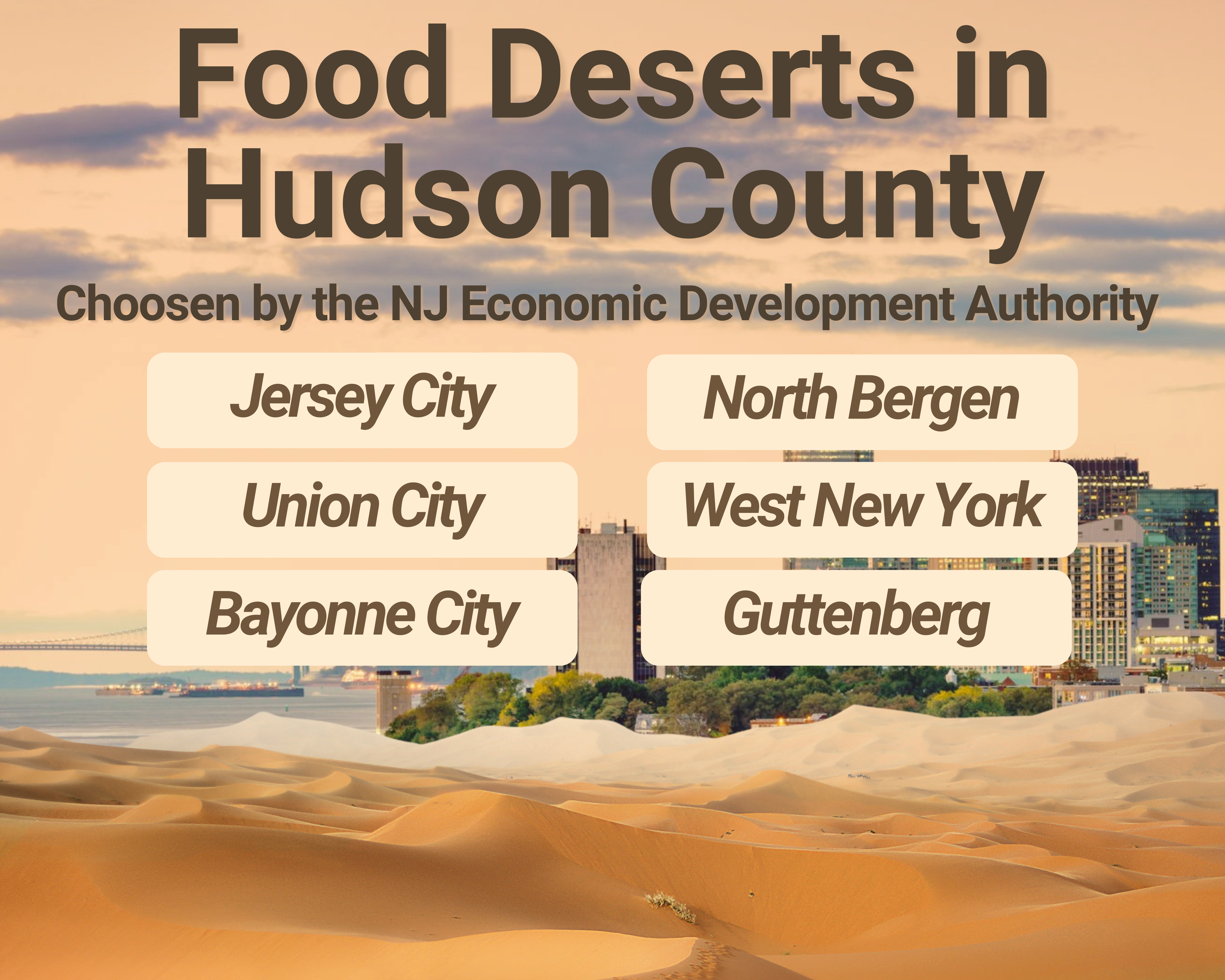Community
In the Heart of the Garden State: Addressing Hudson County’s Food Deserts

What is a Food Desert?
Food Deserts, defined by the Centers for Disease Control and Prevention (CDC), are “areas that lack access to affordable fruits, vegetables, whole grains, low-fat milk, and other foods that make up the full range of a healthy diet.” The United States Department of Agriculture (USDA) analyzes data on factors such as low-income neighborhoods, lack of vehicle access, population identity, distance from a supermarket, etc. In order to be designated as a food desert by the USDA, people must live more than 1 mile from the nearest supermarket or large grocery store.
In January 2021, the New Jersey Economic Development Authority (NJEDA) redefined the term to reflect the food insecurity in the Garden State more accurately.
What makes Jersey City, Union City, North Bergen, West New York, Guttenberg, and Bayonne City Food Deserts?
The NJEDA has identified 50 food desert communities across the state in coordination with the Departments of Community Affairs and Agriculture. Each of the 21 New Jersey counties was designated one food-insecure township, with certain counties having more entries on the list. The NJEDA coordinated a thorough, community-driven process of interviewing residents in the 50 neighborhoods to gather factors for consideration.
The factors outlined for the New Jersey food desert qualification include:
- Supermarket access
- Access to unhealthy food retailers
- Health indicators such as obesity
- Poverty and Unemployment rate
- Income relative to the cost of living
- Public assistance enrollment, including SNAP
- Housing quality
- Violent Crime Rate
- Vehicle, transportation, or walkability access
- % of households with internet access
- Single mother % of households
- Education levels
- % under age 18 and % of students with free or reduced-price lunch
- Density of population
- Race and ethnicity
The 50 communities include:
1. North, Central, and South Camden/Woodlynne – Camden County
2. Atlantic City/Ventnor – Atlantic County
3. Newark South – Essex County
4. Newark West – Essex County
5. Paterson South – Passaic County
6. Camden East/Pennsauken – Camden County
7. Newark East – Essex County
8. Newark North and Central – Essex County
9. Passaic City – Passaic County
10. Salem City – Salem County
11. Paterson North – Passaic County
12. Bridgeton/Fairfield Twp/Lawrence Twp – Cumberland County
13. New Brunswick City – Middlesex County
14. Trenton City – Mercer County
15. Elizabeth East – Union County
16. Asbury Park City – Monmouth County
17. Jersey City South – Hudson County
18. Penns Grove/Carneys Point – Salem County
19. Perth Amboy City – Middlesex County
20. Irvington Township – Essex County
21. Elizabeth West – Union County
22. Union City – Hudson County
23. Lindenwold/Clementon – Camden County
24. Lakewood North – Ocean County
25. Pleasantville/Absecon – Atlantic County
26. Red Bank Borough – Monmouth County
27. East Orange City – Essex County
28. Orange/West Orange/Montclair – Essex County
29. North Bergen/West New York/Guttenberg – Hudson County
30. Long Branch City – Monmouth County
31. Jersey City North – Hudson County
32. Jersey City Central – Hudson County
33. Woodbine Borough – Cape May County
34. Millville/Commercial Twp – Cumberland County
35. Keansburg Borough – Monmouth County
36. Prospect Park/Haledon/Hawthorne – Passaic County
37. Paulsboro Borough – Gloucester County
38. Lakewood South – Ocean County
39. Fairview Borough – Bergen County
40. Linden/Roselle – Union County
41. Egg Harbor City – Atlantic County
42. Burlington City – Burlington County
43. Vineland City – Cumberland County
44. Plainfield City – Union County
45. Phillipsburg Town – Warren County
46. Bayonne City – Hudson County
47. Dover Town – Morris County
48. Bound Brook Borough – Somerset County
49. High Bridge Borough – Hunterdon County
50. Montague Township – Sussex County
How is New Jersey State tackling the food desert epidemic?
Governor Murphy signed the Food Desert Relief Act (FDRA) into law on January 4th of 2021. The FDRA directs the NJEDA to address the food security needs of communities across New Jersey by providing up to $40 million per year for six years in tax credits, grants, and loans which can be awarded to New Jersey food retailers, such as grocery stores or supermarkets, to help increase access to fresh food.
These grants can range up to $250,000 for food retailers that accept Supplemental Nutrition Assistance Program (SNAP) benefits or food stamps. These businesses can set up fresh food and online ordering for SNAP residents. These fresh food self-contained, temperature-controlled packages are then securely delivered to a centralized location in the food desert community for the purchaser to pick up. Currently, New Jersey SNAP recipients can purchase groceries online from 16 retailers, which is shockingly low for the 1.32 million New Jersey residents living in food desert communities.
What is Hudson County doing to help the food desert epidemic?
Thanks to the community-based efforts across Hudson County, there are many ways to tackle this problem at the source – the food source that is!
There are community gardens across the county that provide fresh food not only to those who care for the garden but to the wider population. Creating more gardens that are made and tended to by our community offers the opportunity to teach, learn, and grow together. Other programs that arise from community garden programs include educational seminars on nutritious eating, growing your own produce, and more. Community gardens offer a space for mental healing and physical activity. Gardening is a way to provide a resource while benefiting our local ecosystem.
There are also community fridge programs across Hudson County that reclaim fresh food from individuals or local businesses and distribute it to the greater community. These take the form of a public fridge located outside where individuals can drop off food or pick up food when needed. Similarly, food banks hosted at local churches offer fresh food to anyone who attends their weekly food giveaway events.
These community-led projects inspire us to continue expanding access to fresh food, green space, and other green initiatives throughout Hudson County! Each individual can play a role in a larger movement to restore our local environment and provide a thriving life for our residents.
Contact NBEarthTalks@gmail.com or UnionCityCommunityGarden@gmail.com to collaborate to get something started in your area.








